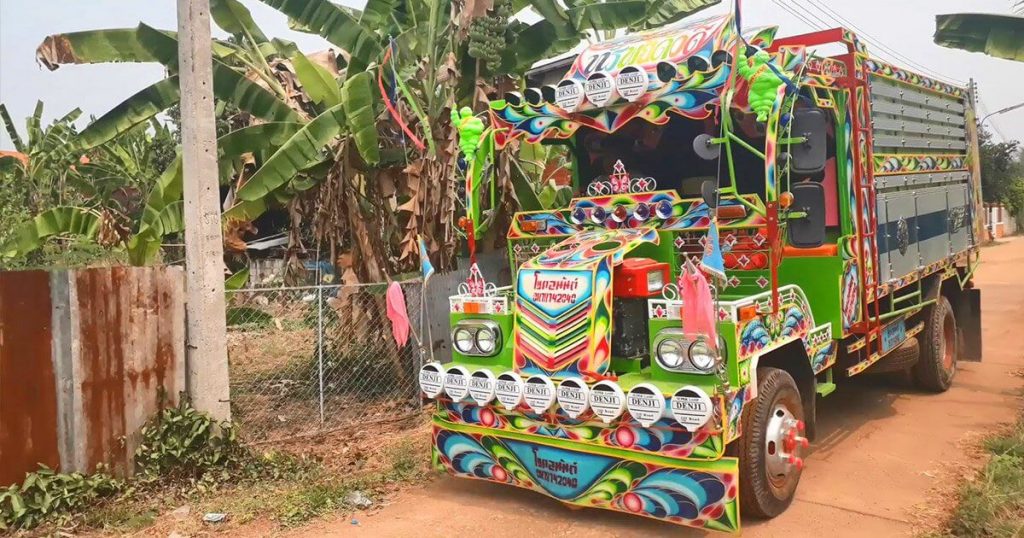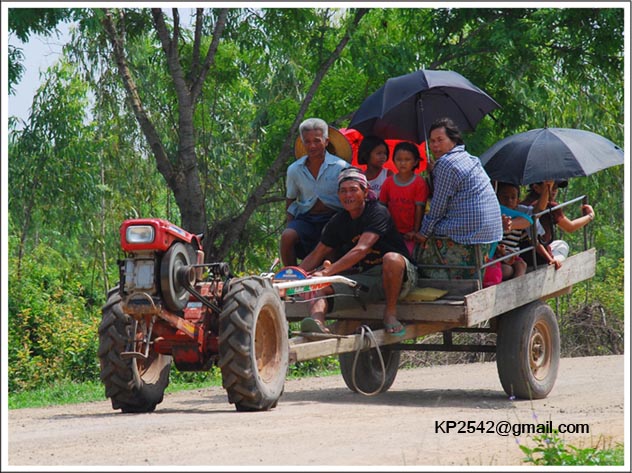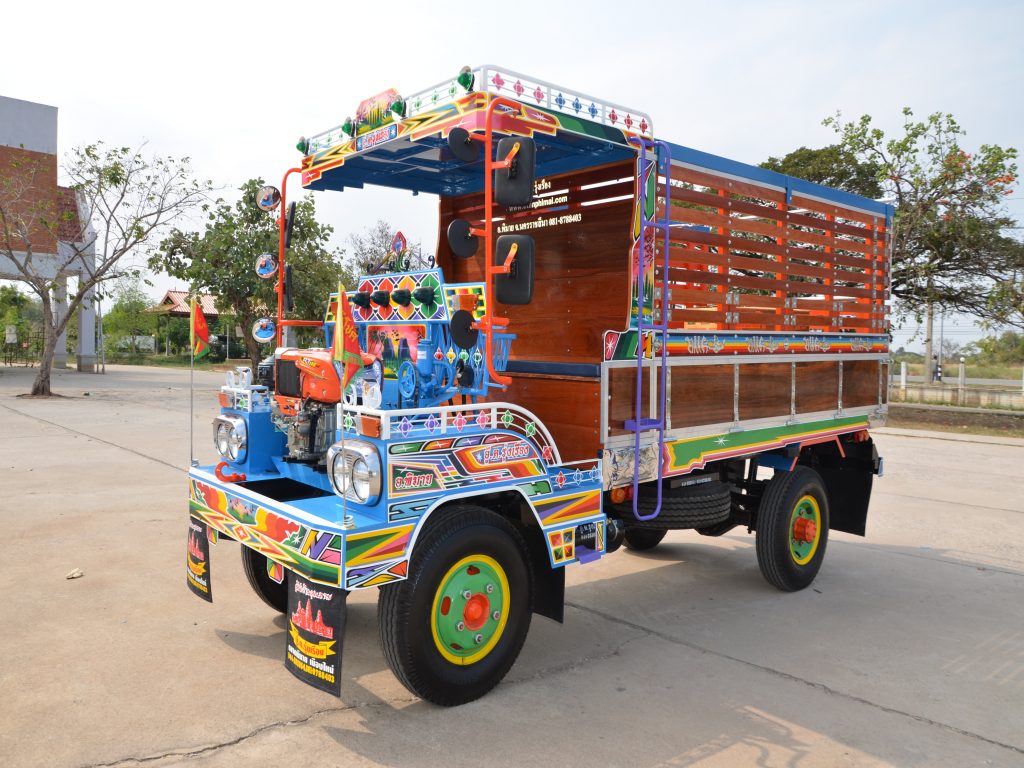E-tan: The Craft and Culture of Thai Tractors

[photo cr. Workpoint Today]
Farmland is not only a breadbasket that nourishes the townspeople and farmers but also a cradle of inspiration behind many labor-saving inventions from carts, to wagons, and to a unique invention by Thai farmers called “E-tak” or “E-tan.”
In the very beginning, farmers used buffalos to pull the plow to prepare the soil for cultivation. Farmers would walk behind the plow while holding the handle to control the direction. Later, with the advent of technology, the buffalos were replaced by “an artificial buffalo,” which is a small engine attached to the plow. Resembling a tractor, the engine-driven plow is called “Ekong.” This knock-on innovation was later used with trailers to transport produce and people around the neighborhood.
“Ekong” is named after a distinctive feature of a walk-behind plow, which is a long handle that bends down to the level of the hands of a plowman. When we attach “Ekong” to a trailer or a wagon and take it to the road, we will be able to hear in the distance the signature engine sound “tak, tak, tak,” thus the name “E-tak.”

E-tak [photo cr. [email protected]]
Continually upgraded, this local vehicle finally incorporated a structure similar to a motor car, with a steering wheel, a brake system, a transmission system, a roof, a greater speed, and beautiful colors. With an appearance and style unmatched by any vehicle on the agricultural fields in that era, this advanced version of “Ekong” was given a new name “E-Tan,” which comes from the Thai word “sa-lan-tan” meaning “exquisite.”
E-tan is a small agricultural tractor locally invented by Thai mechanics to help farmers carry out work in the agricultural industry. This versatile tractor is farmers’ best friend. Not only is it used to transport crops, but it can be adapted to generate electricity and pump water. Sturdy, durable, and suitable for various landscapes and heavy agricultural duties, E-tan is a remarkable common sight on farmland across Thailand.
Nakhon Sawan Province is one of the most important rice cultivation areas in Thailand. During July-August when rice fields on both sides of the road are becoming a lush green carpet, we will be able to see many E-tans running around, particularly in Nong Bua District where a large population of E-tans exists.
Prateep Keawpan, E-tan carmaker and owner of Prateep Garage located not too far from the town of Nakhon Sawan, said that making E-tans “is a meticulous job. We want it to look as perfect as possible. Here, we do almost everything by hand.”
Prateep[1] recounted his childhood memory of E-tans, saying, “Ever since I can remember, I have always seen E-tans.” Prateep did not land his first job as an E-tan maker but as a mechanic in a metal workshop in Bangkok, where he honed a set of skills essential for the production of E-tans. Later, when returning to his hometown, Prateep began to build E-tans. “In the beginning, I didn’t make it this big. The vehicle used to weigh only 3 tons, but today it is 4 tons.” During the early days, Prateep delegated some tasks to other automobile shops. However, as he received more commissions and won customer trust in the quality of his craft, he recruited more mechanics and gradually expanded the business until he was able to provide one-stop service at his own garage.
Prateep pours his heart into the making of E-tans. Each part is manufactured and assembled by hands. “Each of the cars here is original. This kind of work takes a lot of time and not many automakers take this approach like I do,” said Prateep. For example, the process of making a bonnet involves welding, sanding, and shaping. Its time-consuming nature requires the precision and dedication of the makers, not to mention the handmade steelwork which can be an intimidating task if they want to get the right shape. There is no wonder why Prateep radiated joy and pride as he described his creation. “It’s also my personal taste. I like handcrafted work.”
The difference between the wagon building in the past and the manufacturing of E-tans lies in the materials (wood for the former and steel for the latter), tools, and techniques which have become more sophisticated. Still, what remains unchanged is the craftsmanship of vehicle makers in both eras who have created these agricultural vehicles with dedication and meticulousness, as if they were a piece of art.
The body or the chassis of an E-tan is a steel frame that houses the engine and the cabin. The rear part is a pickup trailer made of solid hardwood. The front of the car and the sides are decorated with contemporary Thai patterns. In other words, E-tans are Thai-style tractors.
To manufacture an E-tan, Prateep said, “The process involves welding, painting, drawing, engine work, electrical work, and woodwork.” The mechanics in charge of each part are expert in their own fields. As for Prateep, he oversees the whole production, and specifically the engine and electrical work. Prateep’s son takes care of the welding. There are also a painter and a carpenter in the team. Everyone is doing their own part with great care. It is undoubtedly a way to earn a living, but from another perspective, these E-tan makers are devoted artists. Prateep’s garage does not mass produce cars like a factory does, but is a workshop for craftsmen with different skills to join hands and work together.
The production capacity at Prateep’s is only four cars a year. The making of E-tans does not require so many advanced tools as the expertise and attention of the makers, thus the uniqueness of each car. “Customers may not notice little flaws on their vehicles, but as mechanics, we do. For that reason, we cannot allow any mistakes. We have to make it as perfect as possible,” Prateep said.
Prateep’s Thai tractors feature the Nong Bua style characterized by a long cab similar to that of a vintage large truck. The E-tans manufactured at Prateep’s garage rarely encounter problems with the body. Much of the wear and tear is on the engine as it ages. This proves the high standard of Prateep’s craftsmanship.
Among the common elements that connect the vehicles of the past, such as wagons, with those of the present day, carpentry seems to be the most tangible one. The best wood is hardwood (e.g. Makha or Redwood) sawed to the proper size, coated with lacquer, let dry, and then assembled and installed as a trailer. When freshly finished, the lacquered wood will retain a nice dark brown finish. After being weathered by the rain and the sun, the color will fade, revealing a different kind of charm. Most E-tans that run in Nong Bua will have distinctive patterns around the cab, but the pickup parts at the rear are left undecorated to show the pristine beauty of the wood.
Today, in big provinces where rice cultivation is practiced, E-tan manufacturing businesses still thrive. Each enterprise has a different technology and expertise. Some install suspension systems of pickup trucks in their E-tans, transforming them into exotic racing cars. At Prateep’s, it is more conservative, refined, and traditional. Each car is a tailor-made realized by a skilled and committed team of craftsmen.

E-tan (Manufacturer: Tor Rungrueng) [cr.etanphimai.com]
E-tan is a local handicraft of Thailand, with a unique local identity and way of life fused into its fabric. It is the embodiment of the Thai livelihood which is one with farmland, but also flexible, open, and not afraid to adapt and change through time. Prateep, his team, and other E-tan makers are the creators of these moving masterpieces of the fields. Everyone puts their heart into the work and does the best to return the gratitude to the customers who trust them. Each E-tan is fueled with the pride of its creators and the joy of its users.
[1] From this point onward, Mr. Prateep Keawpan will be referred to as Prateep. In the Thai culture, we always address the other person with his or her first name.
Reference
กมลทวิกุล, ทรงยศ (Kamontawikoon, Songyot). “รถอีแต๋น แรงบันดาลใจ จากท้องทุ่งกสิกรรม (E-tan: Invention inspired by agricultural fields).” Watthanatham Journal: Department of Cultural Promotion, yr. 56, no. 4, October – December. 2017, pp. 90 – 95. Retrieved April 1,
- Link: http://magazine.culture.go.th/2017/4/mobile/index.html#p=91__


